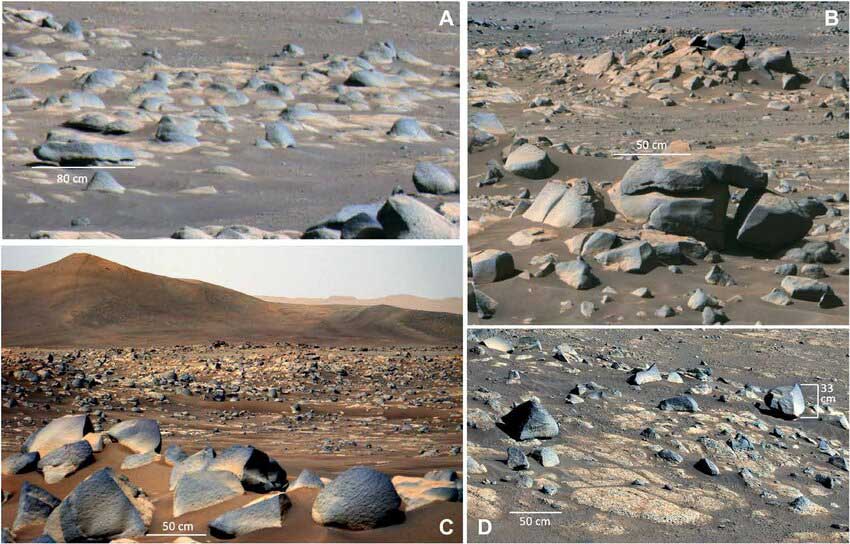NASA’s Perseverance has sniffed 10 rock samples and found signatures of organic molecules, a sign of a complex geochemical past.

NASA / JPL
Planetary scientists analyzing data from NASA’s Perseverance rover have found signs of organic molecules on Mars, hinting that the planet had a more complex geochemical cycle in the past than previously thought. If true, it shows that the building blocks of life have been present on the Red Planet for around billions of years.
These new findings, published in Nature, come from examining the floor of Jezero Crater, a 45-kilometer- (28-mile-) wide impact basin just north of the Martian equator. NASA picked it as Perseverance’s landing site due to geological signs that an ancient river flooded into the crater some 2.5 billion years ago.
Now a team led by Sunanda Sharma (Caltech) has analyzed data from Perseverance’s Scanning Habitable Environments with Raman and Luminescence for Organics and Chemicals (SHERLOC) instrument. It is the first tool we’ve brought to Mars that can map organic molecules, those compounds containing carbon-hydrogen or carbon-carbon bonds. Mounted on the end of the rover’s robotic arm, SHERLOC shines an ultraviolet laser at rock samples and looks for the way the vibrating molecular bonds scatter the light.
Sharma and her team focused on multiple targets on two geological formations on the crater floor called Máaz and Séítah. They detected signals corresponding to organic molecules in all 10 targets they examined; those molecules were trapped within sulfate crystals and were concentrated more in Máaz than in Séítah.
“Seeing that the possible organic signals differ in terms of number of detections, and distribution between the two units of the crater floor was surprising and exciting,” Sharma says. “That opens the possibility of different formation, preservation, or transportation mechanisms across the crater and more broadly, across the surface of Mars.”

NASA / JPL / CC BY-NC 4.0
So where did the organic molecules come from? It is possible that they were left behind by microbes that once clung to these ancient rocks, but Sharma isn’t jumping to that conclusion just yet. “Claiming that life is the source of organics . . . is a last-resort hypothesis,” Sharma says. “We would need to rule out any non-biological source of origin.”
The organic molecules could have rained down from interstellar dust or an impact, but Sharma points the finger elsewhere. “It looks like a set of organics associated with rocks that have had interaction with water,” she says. That would fit with Jezero’s watery past. Aqueous interactions might also explain how the molecules survived extreme conditions on the planet’s surface.
This isn’t the first time that organic molecules have been detected within sulfate crystals on Mars. Planetary scientists have also seen them at Gale crater, the landing site of the Curiosity rover. But now there are measurements from multiple craters. “Extrapolating from just one crater about the whole planet of Mars is like trying to understand all of Earth through visiting New York City,” Sharma says. “Each mission that we have on surface adds more points of comparison so we can move from a regional to a global understanding.”
“This really is an intriguing discovery,” says astrobiologist Lewis Dartnell (University of Westminster, UK), who was not involved in the research. Because the researchers found several distinct pools of organics within Jezero, several processes could be involved in order to account for the variation. “This hints that there may have been a more extensive carbon cycle operating on ancient Mars than has previously been suspected.”
In order to see whether these molecules can be directly linked to life, the sample would need much greater scrutiny than a rover alone can provide. “[We] will have to wait for the Mars Sample Return mission to bring them back to the Earth for full analysis,” Dartnell says.
There’s an ambitious, multi-agency plan to launch a huge, heavy lander in 2028. The plan has it touch down at Jezero and send out a rover (or maybe helicopters) to collect important specimens identified by Perservance, then hurl them back home to waiting scientists by 2033. Only once those samples are in hand will we have a clearer understanding of what these organic molecules really are and how important they may be for the story of possible life on Mars.
 3
3









Comments
PGT
July 12, 2023 at 11:56 pm
In keeping with news from June 17, 2023, “PHOSPHATES SWIM IN THE OCEAN OF SATURN'S MOON ENCELADUS,” any phosphates found in the Martian sniff test?
You must be logged in to post a comment.
Rod
July 13, 2023 at 8:04 am
As this report states, "So where did the organic molecules come from? It is possible that they were left behind by microbes that once clung to these ancient rocks, but Sharma isn’t jumping to that conclusion just yet."
Interesting report. Is this evidence better than what Charles Darwin cited in his 1871 and 1882 letters discussing the origin of life from non-living matter (abiogenesis today)?
https://www.darwinproject.ac.uk/letter/?docId=letters/DCP-LETT-7471.xml&query=warm%20little%20pond#hit.rank2
https://www.darwinproject.ac.uk/letter/?docId=letters/DCP-LETT-13711.xml&query=general%20law%20of%20nature#hit.rank1, "...Though no evidence worth anything has as yet in my opinion been advanced in favour of a living being, being developed from inorganic matter, yet I cannot avoid believing the possibility of this will be proved some day in accordance with the law of continuity3"
You must be logged in to post a comment.
Soflochi
October 6, 2023 at 8:22 am
I feel like we are living a version of the emperor’s new clothes. NASA can be as conservative as they want with using the L word but it should not stop everyone from discussing what’s obvious. Everyone is so afraid of looking like as ass they are afraid to say what’s right in front of them- since I make an ass of myself daily Im not afraid to say - Those boulders are the flash frozen remains of marine creatures. It’s obvious-the uv fluorescence confirms it. They were likely squid or something similar to squid- you can even see a structure from a squid (or similar)’s eyes that fluoresces in a few of them. Perseverance has even done a few studies of the eyes of these things focusing on the pupil since cephalopod eyes and most others on earth developed differently. And since only the images are public but not the studies, who exactly are the studies for if not the taxpayers?
So let’s get the conversation moving-there’s a ton of questions to be answered and at the pace we are going we’ll never find out-
Since they were mostly soft bodied creatures and there is not much decay, they were likely all removed from the water at the same time and flash froze. Meteor? Sink hole? What? And if they are related to squid, how were they in two places? Right now data shows Mars was last habitable for marine life 3 billion years ago- the Cambrian when squid show up in the fossil record was only 500-600 million years ago - huge gap - so did they develop independently since mars and earth have been swapping spit? Just hanging out frozen in space? Was there an intermediary?
You must be logged in to post a comment.
You must be logged in to post a comment.